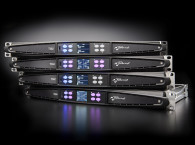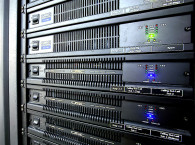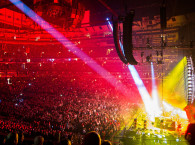Before I dive further into other Audio Collaborative 2019 presentations, topics, and debate panels, I think I should highlight some of the research that was introduced at this event by Futuresource, given the direct interest for our readers. Specifically the presentation by market analyst James Kirby - leading the pro audio research at Futuresource - which provided a valuable overview of the Pro Loudspeaker Market.

The Futuresource research provides that important perspective of the loudspeaker market, analyzing the key verticals and applications, such as touring and rental, studio, portable applications, and installation, characterized by Installed Leisure and Commercial Installation, which includes cinema sound. More importantly, since Futuresource is conducting continuous research on both the professional and consumer markets, the updated data also provides a unique perspective on the overlapping segments and trends, including the middle areas of prosumer applications, which have never been clearly characterized and where many growth opportunities exist. As Kirby stated, "there are some key opportunities from the consumer side and from fast-growing new areas that sit outside the traditional staple pro audio market."
According to Futuresource, the pro audio loudspeaker market represents 43% (or $2.8B) of a USD $6.4 Billion global pro audio industry. Within that, we have all the other product categories, such as microphones (26%), mixers, and amplifiers, which are not nearly as large segments. The most important trend highlighted by Kirby is the 6.5% compound annual growth rate (CAGR) projected from 2018 to 2023 - a consistent growth projection showing that pro audio is a stable and simultaneously reasonably fast growing market.
In fact, professional loudspeakers are projected to grow at an annual rate of 6.9% until 2023, slightly above average, and showing higher growth in volumes than value. "Mainly due to the changing product mix within the pro speaker market. We have volume and revenue shifting - volume will grow at 9% until 2023 - mainly due to the demographic shifts and opening of new markets, expanding the market as a whole," Kirby explained.
Interestingly, due to some convergence with the wider (in volume) consumer space, growing product categories include home studio and portable PA. Futuresource also predicts that the larger growing opportunities will continue in commercial installation products, which is one of the fastest growing applications in the professional loudspeaker market.

The second largest revenue market for professional loudspeakers is portable PA, which represents 25% of the overall pro loudspeaker market in revenue (almost USD $700 million), but is also one of the slowest in growth. Still a very important market for professional loudspeakers, and the largest one, when combined with studio monitors, and where - as Futuresource highlighted for home studios - there are increasingly Direct-to-Consumer opportunities. Regarding those trends, Kirby noted opportunities for Consumer Facing Brands, and the convergence with consumer technologies, such as Bluetooth. Portable PA, where loudspeaker systems are increasingly active, is also typically the most important market by volume for Class D amplifiers.
Touring and rental is where professional audio brands aspire to be, to lead and influence the market. According to Futuresource, a slow growth market (CAGR 4.3%), representing $500 million in revenue in 2018 (or 20% of the overall loudspeaker sales globally), but representing only 1% in terms of volume of the overall loudspeaker market. Notable positive trends for touring and rental are the many new technologies and applications that are being introduced, with immersive systems being increasingly used in place of traditional L/R or LCR configurations, artists increasingly pushing for revenue through touring, growth continuing in festivals and smaller events, and the increased use of small and large-scale sound systems at corporate events.

Finally, commercial installation is the most promising application opportunity and currently the fastest growing, with 10% annual growth and representing already $600 million in revenue. Fast growing applications, recognized globally, include hospitality, retail, background music, cruises, and corporate audio. Conferencing and meeting spaces are also an application contributing to important expansion in this segment, benefiting from the overall investment trend in AV technology in general. The transition towards new advanced technologies, with DSP and microphone arrays, network connected systems, and beamforming applications are all areas of excitement for the audio industry in general, and one that is expected to benefit a lot the loudspeaker industry. According to Futuresource these growth opportunities could represent 35% revenue growth and an $800 million revenue segment.

And the relevance of this market data is highlighted by the fact that Futuresource recently also updated the company's research in the consumer space, covering specifically the loudspeaker market. According to the latest Loudspeaker Market Report, Futuresource characterizes the consumer loudspeaker market as a USD $4 billion plus industry in decline, "moving increasingly toward more premium high-priced products," despite the continued dominance of alternative audio solutions, such as wireless speakers and headphones.
For the consumer space, Futuresource's new Loudspeaker Market Report quantifies Floorstanding, Bookshelf, Home Theater, PC, and Architectural speakers in volume and value, highlighting the growth areas in this declining market and examining new technologies, such as the growth of active loudspeakers. The report looks at which brands are managing to buck the declining trend by analyzing the competitive landscape for the different product categories, including the rate of adoption of wireless active loudspeakers - which is on the rise - or the end user feedback on home theater system use - something that does need to be better understood beyond the pure hype of the soundbar product category.
This article was originally published in The Audio Voice email weekly newsletter. Sign-up here.









